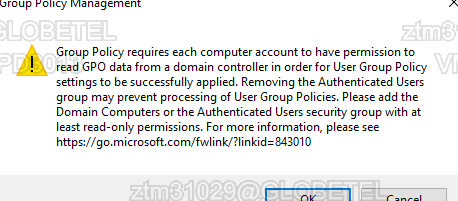
Hello @Janus Bariñan ,
Thank you for posting here.
Q: When I add authenticated users as Read Only in the Delegation tab it get applied. Is this how gpo supposed to work now?
A:: Yes.
When they are computer objects in the OU and we configure computer configuration for these computer objects with security filter, it is recommended we can do as below:
Keep Authenticated users and make Authenticated users have Read permission.
Add computer group (computer object) and make the computer group (computer object) have Read and Apply group policy permissions.
When they are user objects in the OU and we configure user configuration for these user objects with security filter, it is recommended we can do as below:
Keep Authenticated users and make Authenticated users have Read permission.
Add user group (user object) and make the user group (user object) have Read and Apply group policy permissions.
Hope the information above is helpful. If anythig is unclear, please feel free to let us know.
Best Regards,
Daisy Zhou
